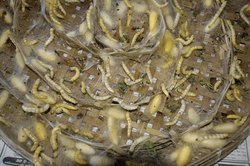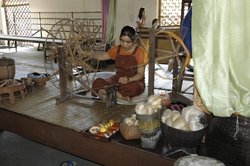Silk
|
|
Silk is a natural protein fiber that can be woven into textiles. It is obtained from the cocoon of the silkworm larva, in the process known as sericulture, which kills the larvae. The shimmering appearance for which it is prized comes from the fibres triangular prism-like structure, which allows silk cloth to refract incoming light at different angles.
| Contents |
Early history
Silk was first developed in early China, possibly as early as 6000 BC and definitely by 3000 BC. Legend gives credit to a Chinese Empress Xi Ling Shi. Though first reserved for the Emperors of China, its use spread gradually through Chinese culture both geographically and socially. From there, silken garments began to reach regions throughout Asia. Silk rapidly became a popular luxury fabric in the many areas accessible to Chinese merchants, because of its texture and lustre. Because of the high demand for the fabric, silk was one of the staples of international trade prior to industrialization.
Silk trade
Perhaps the first evidence of the silk trade is that of an Egyptian mummy of 1070 BC. In subsequent centuries, the silk trade reached as far as the Indian subcontinent, the Middle East, Europe, and North Africa. This trade was so extensive that the major set of trade routes between Europe and Asia has become known as the Silk Road.
Secret
The Emperors of China strove to keep the knowledge of sericulture secret from other nations, in order to maintain the Chinese monopoly on its production. This effort at secrecy had mixed success. Sericulture reached Korea around 200 BC with Chinese settlers, about the first half of the 1st century AD in Khotan, and by 300 AD the practice had been established in India. Although the Roman Empire knew of and traded in silk, the secret was only to reach Europe around AD 550, via the Byzantine Empire. Legend has it that the monks working for the emperor Justinian were the first to bring silkworm eggs to Constantinople in hollow canes. The Byzantines were equally secretive, and for many centuries the weaving and trading of silk fabric was a strict imperial monopoly; all top-quality looms and weavers were located inside the Palace complex in Constantinople and the cloth produced was used in imperial robes or in diplomacy, as gifts to foreign dignitaries. The remainder was sold at exorbitant prices.
Wild Silks
"Wild silks" are produced by a number of undomesticated silkworms. Aside from differences in colours and textures, they all differ in one major respect from the domesticated varieties. The cocoons, which are gathered in the wild, have usually already been chewed through by the pupa or caterpillar ("silkworm") before the cocoons are gathered and thus the single thread which makes up the cocoon has been cut into shorter lengths.
A variety of wild silks have been known and used in China, India and Europe from early times, although the scale of production has always been far smaller than that of cultivated silks.
Wild silks are produced by caterpillars other than the mulberry silkworm (Bombyx mori). The term "wild" implies that these silkworms are not capable of being domesticated and artificially cultivated like the mulberry worms.
Commercially reared silkworms are killed before the pupae emerge by dipping them in boiling water or they are killed with a needle, thus allowing the whole cocoon to be unravelled as one continuous thread. This allows a much stronger cloth to be woven from the silk. Wild silks also tend to be more difficult to dye than silk from the cultivated silkworm.
There is ample evidence that small quantities of wild silk were already being produced in the Mediterranean and Middle East by the time the superior, and stronger, cultivated silk from China began to be imported.
The beautiful and expensive golden-coloured "wild" silk called "Muga" is produced only in the Brahmaputra Valley — mainly Assam and adjoining parts of Burma. This silk has always been highly prized — not only for its beautiful natural golden sheen, which actually improves with aging and washing — but for the fact that it is the strongest natural fibre known. Garments made of it outlast those made of ordinary silk — commonly lasting fifty years or more.
In addition, it absorbs moisture better than ordinary silk and is, therefore, more comfortable to wear. Nowadays, it is mainly sought after for the highest-quality saris given as dowry presents to wealthy brides in India. There is, apparently, quite a racket in India, where other "wild" silks are dyed so they can be passed off as the more expensive Muga variety.
Europe
Venetian merchants traded extensively in silk and encouraged silk growers to settle in Italy. By the 13th century Italian silk was a significant source of trade. Italian silk was so popular in Europe that Francis I of France invited Italian silkmakers to France to create a French silk industry, especially in Lyon. The French Revolution interrupted production before Napoleon took power.
America
James I of England introduced silk growing to the American colonies around 1619, ostensibly to discourage tobacco planting. Only the Shakers in Kentucky adopted the practice. In the 1800s a new attempt at a silk industry began with European-born workers in Paterson, New Jersey, and the city became a US silk centre, although Japanese imports were still more important.
World War
World War II interrupted the silk trade from Japan. Silk prices increased dramatically and US industry begun to look for substitutes, which led to the use of synthetics like nylon. Synthetic silks have also been made from lyocell, a type of cellulose fibre, and are often difficult to distinguish from real silk.
Islam
In Islamic law, there is a prohibition upon Muslim men from wearing silk (as well as gold). While the command is given in the Quran without justification, many jurists believe the reasoning behind the prohibition lies in avoiding clothing for men that can be feminine or extravagant and luxurious. http://www.islamonline.net/fatwa/english/FatwaDisplay.asp?hFatwaID=61261
Animal rights
Silk has recently come under fire from animal rights activists who maintain that the common practice of boiling silkworms alive in their cocoons is cruel.
Other uses
In addition to clothing manufacture and other handicrafts, silk is also used for items like parachutes, bicycle tires, comforter filling and artillery gunpowder bags. Silk undergoes a special manufacturing process to make it adequate for its use in surgery as non-absorbable sutures. Chinese doctors have also used it to make prosthetic arteries. Silk cloth is also used as a material to write on.
See also
- Rayon
- Silk Road
- Spider silk
- Jim Thompson, pioneer of Thailand's silk industry.
References
- Good, Irene. 1995. “On the question of silk in pre-Han Eurasia” Antiquity Vol. 69, Number 266, December 1995, pp. 959-968
- Hill, John E. 2004. The Western Regions according to the Hou Hanshu. Draft annotated English translation.[1] (http://depts.washington.edu/uwch/silkroad/texts/hhshu/hou_han_shu.html)
- Hill, John E. 2004. The Peoples of the West from the Weilue 魏略 by Yu Huan 魚豢: A Third Century Chinese Account Composed between 239 and 265 CE. Draft annotated English translation. Appendix E. [2] (http://depts.washington.edu/uwch/silkroad/texts/weilue/weilue.html)
- Kuhn, Dieter. 1995. “Silk Weaving in Ancient China: From Geometric Figures to Patterns of Pictorial Likeness.” Science 12 (1995): pp. 77-114.
- Liu, Xinru. 1996. Silk and Religion: An Exploration of Material Life and the Thought of People, AD 600-1200. Oxford University Press.
- Sung, Ying-Hsing. 1637. Chinese Technology in the Seventeenth Century - T'ien-kung K'ai-wu. Translated and annotated by E-tu Zen Sun and Shiou-chuan Sun. Pennsylvania State University Press, 1966. Reprint: Dover, 1997. Chap. 2. Clothing materials.
External link
- Silkworm rearing (with photo journals): http://www.wormspit.com


